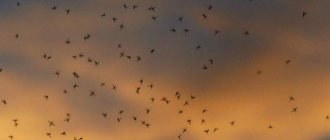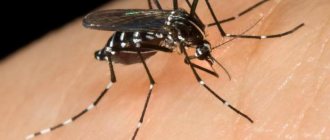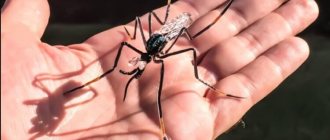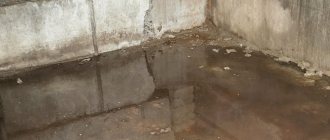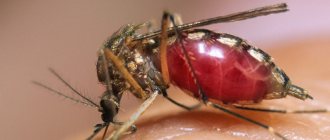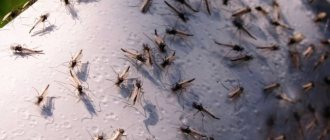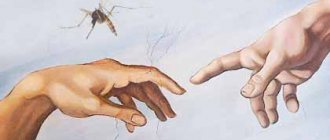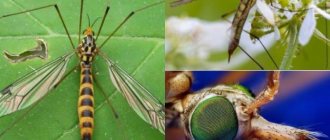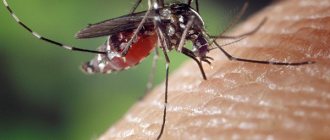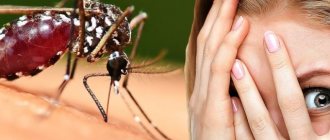What do insects like?
Even with the arrival of absolute darkness, they do not stop their activity.
Nature has endowed the mosquito with a thermal and chemical analyzer, with the help of which the insect senses the presence of carbon dioxide and lactic acid contained in sweat. Moreover, the smell of carbon dioxide can be heard at a great distance, and lactic acid can be smelled a kilometer or more away. It turns out that nature has created several thousand species of mosquitoes, and each of them prefers a certain type of prey: some like to feast on the blood of birds, others prefer to hunt people, others look for prey among animals, etc. There are male and female mosquitoes, and only mosquitoes suck blood.
While on vacation or in a city apartment, many people ask the question: “What will mosquitoes fly to faster: light or warmth? Can turning off the lights save you from these bloodsuckers?
It has been noticed that female mosquitoes love light, so we often see how they strive from darkness or twilight to get to an illuminated place. It turns out that they like the twilight of the night even more than the sultry sunlight. And if the air temperature reaches more than 27 degrees Celsius, the mosquito dies.
Using the thermal receptor, the mosquito searches for open areas of the human body in order to get as close as possible to the food source. By the way, sometimes you can observe that mosquitoes cling to a warm object (for example, a heating pad) and try to stick their nose into it.
An ideal option for lighting a room or summer cottage in the summer are LED lamps and lanterns. Firstly, they are economically beneficial, and secondly, they do not heat up and do not emit heat, which means they do not attract mosquitoes.
What do mosquitoes fly to, and how to cool their impulse? Experts have conducted many studies and identified the main factors that attract mosquitoes:
- Blood type and Rh factor. Of course, it would be ridiculous to say that an insect knows about this concept, but they have studied with confidence that a mosquito determines its blood type by smell (genetically determined). The mosquito loves the first blood group; it is less active in landing on victims with the third and fourth blood groups, but it least likes people with the second group.
- Carbon dioxide. It turns out that the more concentrated the carbon dioxide, the better for the mosquito. That is why he mainly sits on large, adult people.
- Sweat. Due to the fact that mosquitoes are attracted by the smell of lactic acid, ammonia, and uric acid, which are part of sweat, they often hunt for a working person who sweats heavily. If a person just got out of the shower, he becomes completely uninteresting to the mosquito.
- Beer. An interesting proven fact is that beer drinkers are the favorites of mosquitoes. Why? This is presumably due to ethanol released through the skin and increased body temperature.
- Color spectrum of clothing. According to statistics, bloodsuckers are attracted to black, red and dark blue clothing. Why this is so is unknown, but the fact is a fact.
- Bacteria that accumulate on the surface of human skin. Moreover, there are a number of bacteria that attract insects, and there are those that repel them.
- Pregnancy. Experts noticed attraction to pregnant women by observing the malaria mosquito, and then analyzed the behavior of many other species and confirmed this fact. The reason that women in an interesting position have become the favorites of harmful insects is their body temperature (higher than that of an ordinary person), and more carbon dioxide that they exhale.
By the way, there is a fun fact that there are a number of people who are not interested in mosquitoes at all. These are the lucky ones whose bodies from birth are able to secrete a natural substance - a repellent that mosquitoes cannot tolerate.
The first stage of the hunt - mosquitoes fly to the smell
It is known that a mosquito can smell its “prey” at a distance of up to 50 meters, especially if the person emits a lot of carbon dioxide. Definitely, mosquitoes fly to carbon dioxide, which has been confirmed by numerous experiments.
Large people, pregnant women and those who exercise outdoors emit a lot of carbon dioxide. As they fly closer, other odors become the determining factor for insects. Mosquitoes are attracted to people who have an excessive concentration of cholesterol or steroids on their skin surface. Entomologists say that bloodsuckers are attracted to uric acid if it is produced in excess by the body. Insects like people with diabetes, all because mosquitoes like the air they exhale, which smells of acetone and estradiol.
Mosquitoes will notice the smell of alcohol and sweat. Yes, mosquitoes fly on sweat. The more you sweat, the more likely it is that you will be bitten and not your neighbor. Along with sweat, uric and lactic acid and ammonia are released.
Japanese researchers found that a person who drank a bottle of beer was more attractive to mosquitoes than someone who did not drink alcohol.
What do mosquitoes fly to when they bite? First of all, they use a chemical analyzer to look at carbon dioxide and odor. If you want to deceive them by confusing them with the strong smell of perfume, then you will fail. But a person who has just taken a bath or got out of the shower is less attractive from a mosquito’s point of view.
However, perfume with the scent of vanilla, lavender, and eucalyptus will repel mosquitoes. They don't like the smell of smoke either.
Lovelace mosquitoes
It turns out that mosquitoes are “driven crazy” by the high content of sex hormones in human blood, as well as exquisite perfumes, especially aphrodisiacs. The question is, how do they then differ from humans? So on a date, your excitement and subtle aroma of perfume will be appreciated not only by your partner, but also by the mosquitoes wandering around!
In general, mosquitoes are not averse to biting women, especially during pregnancy: they smell cholesterol, the level of which increases during hormonal changes in the body.
Priority Goals
Mosquitoes distinguish people based on several factors:
- carbon dioxide - the more it comes from a person, the higher the chance of attack;
- temperature – people with elevated body temperature are more likely to become a food source;
- odor – odors of sweat or alcohol emanating from a person attract mosquitoes.
Repellents that camouflage the victim force the mosquito to look for another warm-blooded creature. If one person is protected and the other is not, then all the pests will rush to the defenseless food source.
Hiding from a mosquito is not easy. The use of mosquito nets and insecticides will help confuse the pest or kill it.
How mosquitoes find humans
The activity of unpleasant bloodsuckers and their ability to find victims surprises many. Even in complete darkness, mosquitoes do not stop their activity. Therefore, the question of how mosquitoes see is one of the most frequently asked questions.
On a note!
Insects “see in the dark” thanks to the thermal and chemical analyzers that nature has endowed them with. With their help, mosquitoes smell the lactic acid contained in sweat and the presence of carbon dioxide that a person exhales.
A lamp burning in the room also attracts the attention of insects. However, only female mosquitoes fly into the light. Their attention is drawn to the warmth emanating from the light source. This is what the mosquito focuses on during flight, whether it is light or dark.
Using a thermal receptor, mosquitoes also look for bare areas of the human body, trying to get as close as possible to the food source. However, bloodsuckers are often deceived by clinging to warm objects in anticipation of a meal (a photo of how mosquitoes see is presented below).
How to get rid of an annoying mosquito?
Those who did not manage to fall asleep in the evening before the buzzing bloodsucker appeared will agree that mosquitoes have now become much smarter. Previously, it was enough to turn on the light sharply and slam him while he was drinking blood. Now, in the light, the insect quickly disappears, rushes chaotically around the room, and it becomes impossible to quickly catch a mosquito.
Today's mosquitoes enter the room in the dark and fly to the source of increased temperature, not only through the windows, but also with the help of ventilation. Some “victims” claim that these creatures even “climb” to the ninth floor in the elevator!
Ways to enter the house
First you need to find all the places and loopholes where mosquitoes come from and how they get into the apartment. These insects love high humidity, so you first need to inspect the basement of the house: if there is water or flooding, then even with the doors closed, mosquitoes will be able to enter apartments, especially on the lower floors. By opening the entrance doors each time, the residents themselves let them into the premises.
Another source of their entry into the apartment is windows, because on hot summer days they are always opened to allow fresh air to enter. And mosquitoes always smell a person and are able to “seep” even into the smallest crack. Optimal protection is provided by metal-plastic windows with special mosquito nets, which are made of stainless metal.
If the windows in the apartment are wooden, then you need to purchase a good mesh or gauze and nail them to the frames with special buttons, without leaving the slightest gap for mosquitoes. This method is the best insect repellent. Likewise, the ventilation openings should be closed, leaving them “not a single chance.”
On a note!
Each individual has more than 70 receptors that help capture a variety of odors. Mosquitoes are attracted to aromas: human sweat, ethanol in alcoholic drinks. There are also suggestions that mosquitoes do not bite all people, but prefer to attack people with blood types 1 and 2, children and pregnant women.
What attracts insects to your apartment?
Most often, mosquitoes enter a person’s home by accident, for example, by flying into an open window or a wide open door. But it also happens that an insect flies into a room on purpose. This can happen when it gets cold outside. Then mosquitoes look for more comfortable conditions. A hungry female may be attracted by the scent of the prey. Sometimes mosquitoes fly into a room by smelling the smell of sweat or carbon dioxide.
Swarm of mosquitoes
Features of the aerodynamics of a mosquito
In the process of studying the life activity of mosquitoes and, in particular, the specifics of their flight, scientists found out several interesting facts:
- the wingspan during flight is about 40⁰, which is less than that of other insects;
- the frequency of flapping reaches 700–800 per second, which is 3-4 times more than that of other insects similar in size to mosquitoes.
Another distinctive feature is that after each flap, mosquito wings make a turn, which is why peculiar air currents are created around the insect.
At what altitude do mosquitoes fly?
It is a fairly popular opinion that the flight height of a mosquito does not exceed 12–15 m. However, these data are very conditional. The height to which an insect can rise depends on several factors. To which floor mosquitoes fly depends on the speed and direction of the wind, air temperature, and atmospheric pressure.
In practice, bloodsuckers can be found in apartments on both the 3rd and 9th floors.
Where do mosquitoes come from in an apartment?
Despite the fact that female mosquitoes feed on the blood of people, insects prefer to live in the natural environment. However, meeting them in an apartment, and even more so in a country house, is a common occurrence. So where do mosquitoes come from in a human home:
- from the street;
- from neighboring premises;
- from the stairwell, from the garbage chute.
In addition, blood-sucking insects are common inhabitants of the basements of many private and multi-storey buildings, where they are attracted by warmth and dampness. From there, they easily penetrate into living spaces through ventilation.
Science to help
Just a few years ago, scientists learned to effectively deceive the tactile and olfactory systems of blood-sucking insects by creating a completely new mosquito repellent.
They found that all the sensory hairs on the mosquito's maxillary organ are connected to three neurons: to detect octenol (a substance that mimics the smell of lactic acid), carbon dioxide and to generally enhance the sense of smell. These are the mechanisms that scientists have adopted in the fight against mosquitoes.
They created a trap that releases small amounts of carbon dioxide and an organic attractant containing octenol, something that can attract mosquitoes from several kilometers away. The body of the creation has a rough surface, very similar to human skin, and generates heat, which finally lulls the vigilance of the bloodsuckers.
Unsuspecting insects approach the surface, and then they are sucked inside by a stream of air, and already inside they are killed by a small discharge of electric current. Cruel? Not at all! This is very effective when you want to protect yourself and your family from unbearable bites. Thanks to science for this!
It became known how mosquitoes “see” the warmth of their victims
TASS, February 6. Malaria mosquitoes and their closest relatives have learned to “see” the body heat of humans and animals using receptors that other insects use to protect their bodies from hypothermia. This conclusion was reached by geneticists whose article was published in the scientific journal Science.
“Mosquitoes carry diseases that kill over 700 thousand people every year. These insects use heat to find warm-blooded prey. “We show that the ancestors of mosquitoes acquired this ability during the transition to a new “diet” by adapting a receptor that their dipteran relatives used to protect themselves from the cold,” the researchers note.
Mosquitoes find victims in several ways at once. First, insects calculate their position by the excess carbon dioxide in the air, and then use body heat, as well as steam and lactic acid molecules, which are present in the sweat of humans and animals, in order to select a point for landing.
In the hope of creating products that will repel insects or make them ignore humans, biologists have been studying how mosquitoes' sense of smell and thermal vision work for quite some time. This research has become especially important in recent years as mosquitoes become increasingly resistant to chemicals and traps.
Harvard geneticists and their colleagues were interested in how African malaria mosquitoes (Anopheles gambiae) learned to “see” the heat that radiates from the body of their victims and distinguish it from other sources of infrared radiation.
"Thermal imager" of mosquitoes
Scientists have been trying to find a “thermal imager” for these blood-sucking invertebrates for quite some time, but all the known genes that insects and vertebrates use to measure the temperature of the environment and avoid overheating did not play a similar role in the body of mosquitoes. Blocking and removing them had no effect on the ability of malaria carriers to find new victims.
The authors of the article approached this problem from the other side, noting that fruit flies, distant relatives of mosquitoes, have another type of receptor that helps avoid hypothermia. This led researchers to believe that mosquitoes have learned to “see” heat using such cells.
Geneticists have monitored how the behavior of Anopheles gambiae changes if the genes responsible for the functioning of three such receptors, IR21a, IR25a and IR93a, are removed from their genome. Experiments have shown that the role of mosquito “thermal imager” was played by IR21a receptors, which cover a significant part of insect antennas.
Scientists have found that these nerve cells are very sensitive to temperature changes, especially in the region between 30 and 37 ° C, which includes the typical body temperatures of humans and those animals whose blood malaria mosquitoes drink. The loss of these neurons made Anopheles gambiae's hunting about three times less successful, even when all the chemical "identifiers" of the human body were present alongside them.
Removing the gene also led to the fact that insects with damaged IR21a receptors stopped responding to the movements of the scientists’ hands and fleeing from their blows. This allows us to hope that drugs that block the operation of this part of mosquito antennas will significantly make life easier for all their victims, scientists conclude.
What Attracts Insects
After conducting numerous studies, experts were able to determine that the attention of mosquitoes is attracted by the presence of the following factors.
Mosquitoes
The smell of blood
For many, this will seem absurd, but bloodsuckers find victims by the smell of blood, which is genetically determined, which makes you wonder which group of people mosquitoes bite more often. It is assumed that they give preference exclusively to people with blood type 1. They are more indifferent to a person with blood group 3 or 4. Vampires do not like type 2 blood at all.
On a note!
Hunting for people is carried out exclusively by female mosquitoes. To breed offspring, females drink blood, as it contains proteins and enzymes. Males are absolutely indifferent to blood. They feed exclusively on plant foods, using nectar and plant juice. Females can also be vegetarians, but they will not be able to lay eggs during this period.
Thermal radiation
Special very sensitive sensors located on the antennae help the female blood-sucking mosquito find a suitable victim. They are very responsive to thermal radiation that comes from a person or other warm-blooded creature. Moreover, bloodsuckers especially feel bare areas of the body.
Carbon dioxide concentration
Carbon dioxide also attracts the attention of bloodsuckers. Insects can sense it from human breath at a distance of several tens of meters.
On a note!
Moreover, the higher the concentration of carbon dioxide, the greater the appetite of the insect that produces it. The largest amount of it is produced by people who are overweight.
The smell of sweat
Another factor that attracts the attention of blood-sucking insects is sweat. Therefore, they often choose an actively working person as a victim. To be more precise, bloodsuckers fly to the smell of ammonia, lactic and uric acid, which are part of human sweat.
Perfume will not help in this case, especially if it contains musk. After all, this aroma is very attractive to insects. Therefore, it is not the best option to use cosmetics with a strong smell, be it perfume, deodorant or hairspray. But a person who has just taken a shower will not arouse any interest among bloodsuckers.
Mosquitoes and the smell of sweat
The smell of beer
Scientists have discovered another surprising fact about mosquitoes. The smell of beer, or rather the people who drink it, attracts mosquitoes no less. This addiction is explained by ethanol released through the skin and increased body temperature, which is usually observed among alcohol drinkers.
Gender
Most often, children and girls become victims of mosquitoes. This fact is explained by the presence of thinner skin, which is much easier for insects to bite through than the skin of a male.
On a note!
According to a number of studies, experts were able to discover that mosquitoes are of particular interest to women during pregnancy. It turned out that the volume of carbon dioxide they exhaled was almost 20% greater. In addition, pregnant women have a slightly elevated body temperature.
Women during the period of ovulation also attract no less attention from bloodsuckers. The reason for this is the smell of cholesterol, the level of which increases in women during hormonal changes. This is exactly what mosquitoes react to.
Color of things
The color of clothing can also attract the attention of insects. According to statistics, bloodsuckers are especially not indifferent to black and blue tones, and red also attracts insects. They are neutral to gray. Less attractive colors include yellow, green and khaki.
Interesting!
Those people who have had a special bloodsucker-repellent repellent present in their bodies since birth are not attacked by annoying insects.
The second stage is vision, whether mosquitoes fly towards the light
When we talk about mosquitoes, their habits and behavior, we mean females. Only they need to feed on blood, which they need to lay eggs and reproduce.
Why do mosquitoes fly towards the light? They are attracted to the warmth emanating from lamps and other light sources. Light itself does not attract them; they do not see it in human understanding.
Mosquitoes fly into the light from a lamp or fire; they perceive it as a beacon of infrared radiation. Infrared radiation is detected by special sensors on their antennae. It has been established that LED lamps that do not heat up are not interesting to mosquitoes.
But mosquitoes have preferences in choosing colors. Insects have poor eyesight, which means it’s easier for them to find a dark silhouette. Bloodsuckers are partial to blue, black and red shades. This is the answer to the question - what color do mosquitoes fly to? Moreover, gray is a neutral color for them. Khaki, green and yellow are the least attractive colors.
Compound eyes are the organ of vision of insects; they detect ultraviolet rays and distinguish color. But they do not see small details, but they distinguish flickering objects well.
Mosquitoes are guided by the infrared color that comes from a person or animal, and find where to land by the heat generated. To search for food, mosquitoes use vision at a distance of 5-15 meters.
Blue lamps, insect traps that attract midges, are useless against mosquitoes. Butterflies and moths fly into the light, and mosquitoes are attracted to the warmth.
Facts from Adaptive Capacity
In the summer, you can find mosquitoes everywhere. Initially, blood-sucking creatures lived in the wild near water bodies, in swampy places, and deciduous forests. However, gradually some moved to urban settlements. Nowadays you can find a mosquito in any metropolis.
Mosquitoes
They live in damp basements, entrances, outbuildings, near garbage cans, thickets in the yard, and city parks. Eggs are laid in damp soil, on pipes, where condensation, wet rags, and rotten leaves constantly collect. Since the development of larvae cannot be called complete, the generation of urban mosquitoes is much weaker than swamp ones.
Mosquito attractants
Mosquito traps
Many products have been created to protect against mosquitoes, which are produced in the form of aerosols, sprays and creams. Folk remedies are also popular. However, traps or, as they are more often called, mosquito killers, are considered safer.
- A heat trap is a means of attracting mosquitoes using heat. Such units are designed for use both indoors and outdoors. The most popular electric lamps are the Terminator and the SITITEK Sadovyi-M mosquito killer.
- A carbon dioxide trap imitates human breathing. Bloodsuckers perceive the gas released into the atmosphere as a trace of human activity, feeling it tens of meters away.
- A water trap is distinguished by the presence of an open tray with water. After all, it is in water that female mosquitoes usually lay their eggs. Therefore, it is enough to periodically add and replace water, disposing of caught insects.
- Electric traps kill mosquitoes using an ultraviolet lamp, the light and heat of which attracts them. It is equipped with a built-in grid to which voltage is supplied. As soon as the insect touches it, it dies from a discharge of electric current.
- The propane trap is intended for outdoor use only. It works by releasing CO2 and special lures that imitate the smell of human sweat. One of these devices is the Kornami no KRN-5000 turbo PRO device.
Many craftsmen make their own mosquito traps using plastic bottles or paper soaked in a mixture of rosin, linseed oil and honey. Safety and accessibility are the main advantages of such devices.
Traditional methods of getting rid of mosquitoes
Along with modern mosquito repellents, there are a huge number of natural remedies to combat these insects. The use of these methods is especially important when there is a small child, a pregnant woman, or pets in the house.
The most common are the following folk methods.
- Decoctions with the addition of various herbs and essential oils. Mosquitoes in an apartment cannot tolerate the smell of plants such as vanilla, cloves, and wheatgrass root. A decoction prepared from one of these plants can be lubricated on exposed skin - it is excellent against mosquitoes. Such a drug will certainly drive away unwanted insects.
- Vanilla can also be added to baby cream and safely used for the care and protection of children.
- The aroma of vinegar will easily drive away mosquitoes. It must be mixed with water in a 1:1 ratio and you can wipe the skin. After a few minutes, the aroma will no longer be felt by people, but will remain very unpleasant for mosquitoes.
- You can also evaporate valerian, 100% eucalyptus extract, cedar and camphor oil in a water bath.
- It is permissible to add essential oils to the aroma lamp. Oil extracts of clove, anise and tea tree are excellent.
- Scented oils can also be applied to light bulbs.
- Also, mosquitoes in the apartment will not be able to tolerate the presence of basil leaves or tobacco.
- You can plant tomatoes or geraniums on the window. Another option for using flowers is to place a bouquet of lilacs or bird cherry in the room.
- Garlic is no less effective in fighting mosquitoes, but due to its strong smell, not everyone is ready to use it. Just chop a couple of cloves of garlic and put it on the windowsill - a good night is guaranteed.
In the fight against mosquitoes, you can use improvised means. For example, prepare a spray at home. It will be a natural product without chemicals. To prepare you will need:
- 2 tbsp. l. vodka;
- 25 drops of essential oil with any repellent scent;
- 2 tbsp. l. vegetable oil;
- 1 tbsp. l. aloe juice
In a spray bottle, mix vodka with essential oil with a few vigorous movements. Then add vegetable oil and aloe, mix again with shaking movements. Before applying the spray to the skin, you need to check for an allergic reaction. To do this, spray a little cream on a small area (usually the wrist). If no changes have occurred after 5 minutes, the product can be sprayed onto the entire body.
Cloves are an effective folk remedy that repels mosquitoes. The easiest way is to add the spice to half a lemon and leave overnight. You can prepare a decoction and use it as a spray. To do this, boil dried carnation flowers in water for 20 minutes.
Vanillin helps avoid mosquito bites in nature. Not to be confused with vanilla sugar. The fragrant substance has a bitter taste and a specific odor. The difference between vanillin and sugar is that it repels insects, while sugar, on the contrary, attracts them. The product can be used in the form of a solution or cream and prepared independently.
To prepare the solution you will need 1 liter of water and 2-3 tsp. vanillin. You need to mix the substance with water and use it as a spray. To turn an ordinary cream into a homemade mosquito repellent, add 1 g of vanillin to 10 g of product and apply to exposed areas of the body.
Vanillin is a reliable protection against insects, does not cause allergies or itching, and is safe for children. The disadvantage of this remedy is its short duration of action - no more than 30 minutes. Then the procedure will have to be repeated.
Folk remedies are safe assistants in the question of how to get rid of mosquitoes at any time of the day. But even natural remedies have contraindications. Basically, this is an individual intolerance to one of the ingredients. Before using any product, you should always test the reaction on a small area of skin.
Household chemicals
Mosquitoes are extremely annoying and pestering creatures. You can meet them in a living space at any time of the day, in winter, autumn, and especially in summer. An interesting fact for the joy of all misogynists: only females drink our blood - males adhere to vegetarianism, preferring flower nectar.
To combat them, the chemical industry is inventing more and more new means every day: all kinds of aerosols, creams, ointments and sprays containing insecticides - substances that repel bloodsuckers. Their main disadvantage is their possible allergy.
In addition, it is not always pleasant to apply these products to the skin, and in the summer it is sometimes simply inconvenient. Entire houses can be protected from attacks by bloodsuckers, for example, with the help of fumigators, plates and ultrasonic equipment.
What Attracts Mosquitoes
A summer walk in a forested area is inevitable without mosquito bites, but there are people who are more attractive to bloodsuckers, and those who are practically not bitten. Those who have suffered from their “deliciousness” inevitably ask the question: what attracts mosquitoes?
How mosquitoes find a person from a distance
Finding a victim to bite is the task of only the female mosquito. The insect needs protein and iron to breed offspring, so the search for a warm-blooded donor is refined to the smallest detail. A mosquito can notice an animal or person following the CO2 trail from as early as 50 meters and change the direction of flight towards the future victim. Inhaled gas is the main bait for bloodsuckers.
Mosquitoes' sense of smell is also excellent: the parasite smells sweat, perfume, and even determines by smell what bacteria are present on the skin. Vision is secondary for the insect, but the female considers moving objects first. Their body temperature is higher, so bloodsuckers choose large, mobile victims more often.
What attracts insects to humans?
The victim of a mosquito can be any warm-blooded animal, but it is people who cause the greatest stir. Human blood is not unique in composition, which means there are other reasons:
- the smell of blood. It comes from previously combed bites, abrasions, scratches;
thermal radiation is more intense during movement, but quite noticeable even at rest. Mosquitoes fly to warmth at night;
carbon dioxide concentration. A person exhales carbon dioxide and also produces it during the combustion of fuel. A mosquito may fly toward a highway, attracted by the CO2 plume;
the smell of sweat, especially fresh sweat, is attractive to bloodsuckers, who receive a signal from afar about tasty prey;
bacteria on the skin - the same ones that feed on sweat and sebum, also have their own specific odors. A person feels them only in high concentrations, but literally a few aromatic molecules are enough for a mosquito;
the smell of beer, or rather, hops, is very attractive to mosquitoes of both sexes, and since the female feeds not only on blood, but also on nectar, she will fly much more willingly to the combination of smells of hops, sweat and fermentation;
Homemade fumigators and traps
There is another way to temporarily forget about the existence of mosquitoes. Cut a lemon or orange in half, inserting about a dozen clove buds into each half. This fragrant and, most importantly, harmless fumigator will allow you to sleep peacefully even with an open window.
You can make a mosquito trap from scrap materials. Take a regular plastic bottle, cut it into two parts so that the neck is slightly shorter than the base. Pour a glass of hot water into it, add 50 grams of sugar and a spoonful of yeast.
Stir and insert the funnel formed from the neck into the base so that it does not touch the water. Wrap the structure in paper or cardboard. Such a simple and effective device can be made together with your child, at the same time teaching him a lesson in chemistry and cooking.
Yeast dough releases carbon dioxide during fermentation, which attracts insects. But they can’t get back out.
An elegant, I would even say, designer mosquito repeller can be made as follows.
Take four glass jars, place two branches of rosemary inside each, and cover them with a few slices of lemon. Pour plain water, filling the jars three-quarters full.
Add ten drops of your favorite essential oil (e.g. peppermint, lavender, cedarwood) to each container. Add a little more water. Place floating candles there, light them - you are guaranteed a romantic evening without unnecessary squeaking bloodsuckers! The fluid must be changed weekly.
Scope of application of traps and exterminators
As application experience and customer reviews show, it is advisable to install destroyer lamps and electric traps in the following cases:
- in cafes and restaurants, on terraces, warehouses, in office premises or in the kitchen;
- on livestock farms to protect animals from midge bites;
- at dachas and personal plots to reduce the number of mosquitoes, gadflies and other flying garden pests;
- in warehouses to combat food moths.
On a note!
Unfortunately, outdoor traps and exterminators have absolutely no effect on cockroaches, fleas and crawling insects, even when installed on the floor. UV light does not attract them, but rather scares them.
Insect mosquito problem
Problems associated with the increasing number of insects in summer have existed since time immemorial. Our ancestors fought mosquitoes in the apartment in their own way, mainly using improvised means and folk recipes. Fragrant herbs, decoctions and dried leaves of wormwood served as some kind of amulets against annoying pests. With the development of technology, opportunities have increased, and mosquito control at home has become a little easier. But distrustful buyers to this day prefer to resort to the advice of grandmothers, destroying the bloodsucker “the old fashioned way.” The time-consuming method, although it clearly demonstrates the results, is ineffective and leaves much to be desired. There are a couple of significant factors that you can consider to significantly reduce your mosquito problem. First, check if there is stagnant water or high moisture in the basement, because moisture-loving insects will breed there. Protection on the windows would not hurt, as a precaution - mosquito nets, screens on the doors. Recent studies have shown that mosquitoes are attracted to the smell of sweat, and therefore personal hygiene in the summer is of particular strategic importance.
How to fight mosquitoes in an apartment?
You can fight mosquitoes in an apartment or house using 2 strategies:
- Destroy annoying insects.
- Take measures to ensure that they leave the premises themselves and do not return.
In order to get rid of mosquitoes in an apartment, use such means as:
- insecticides (in the form of sprays, aerosols, solutions, concentrates, emulsions);
- fumigators (when connected to the network, they begin to evaporate into the air a substance that affects the nervous system of insects);
- traps (depending on the variety, they kill mosquitoes with an electric discharge or are sucked into a special container where they die).
To help repel insects:
- special means – repellents;
- essential oils (eucalyptus, tea tree, lavender, lemon);
- herbs (lavender, geranium, basil) or herbal decoctions;
- spices (anise, cloves).
To prevent mosquitoes from returning, you need to take care of mosquito nets by installing them not only on windows, but also on ventilation openings.
Features of use and safety precautions
Although harmless, insect traps should be used with caution. The devices operate on current; the grid is under constant voltage. For an adult, touching the grille will not be painful - a slight tingling sensation and numbness, but for a child or a pet it can be frightening. The grates are covered with plastic, but children love to stick their fingers into all the cracks, so it is better to place the trap destroyer where the child cannot reach it.
And a few more recommendations for using devices:
- Suspended modules are installed strictly according to the instructions. The distance to the door should be approximately 3 m. Table night lights are placed no closer than 5 m from the person.
- The tray is regularly cleaned of insects. First, the mosquito trap is disconnected from the power supply, the tray is taken out, washed, dried and put back in place. After this, the device is put into operation.
- Make sure that no water gets inside the structure. This may cause a short circuit.
The device is so simple that it will not cause any difficulties in maintenance and operation. The device can fail only due to incorrect installation or violation of the rules of use (water got in). There is simply nothing to break in the traps.
How to get rid of mosquitoes in the countryside
A female mosquito only lives for a couple of weeks, but during this time she can lay thousands of eggs.
And these mosquito eggs can hatch within 24-48 hours! Your goal is to prevent her from laying eggs, thereby disrupting the mosquito's life cycle.
Plant plants that repel mosquitoes
Avoid planting plants that retain water, such as bromeliads.
If you want to grow bromeliads, be sure to water them at the base to avoid the cup-shaped plants from filling with water.
One fragrant plant won't keep mosquitoes at bay, but a yard filled with a riot of grasses and other mosquito-repellent plants can make a difference.
Plant the following plants on the site:
- mint;
- lavender;
- marigold;
- chrysanthemums;
- lemongrass;
- citronella;
- rosemary;
- basil;
- Melissa;
- lemon thyme.
If you don’t want to make your own mosquito repellent, you can buy a natural remedy in the store. For example, mosquito repellent from MommyCare, Levrana, Mi&ko. I buy all my products from online stores.
Now you know how to get rid of mosquitoes at home using improvised means. Share your proven recipes in the comments.
Eliminate standing water
The first step in mosquito control for your yard is to eliminate standing water.
Even a small amount of water can become fertile ground for them.
Tips and tricks
- Adults with allergies should avoid using products with strong odors. Some natural remedies cause severe allergic reactions.
- In children, blood moves more actively, so they rely on special children's creams and sprays. Apply the cream carefully, avoiding contact with eyes, mouth and wounds. If contact occurs, rinse the affected area thoroughly with plenty of water.
- Spray “Sun” does not have pronounced odors and substances harmful to the child’s skin and respiratory tract. Can be used for children from 1 year. Spray the product at a distance of 10 to 15 cm from the child’s skin. Treat the skin no more than 3 times a day.
- Attention! It is better not to use untested products for children. The packaging must contain the following inscription: “Tested by the Moscow City Disinfection Center. Hypoallergenic. Approved and recommended by the Federal State Institution "Moscow Research Institute of Pediatrics and Pediatric Surgery of the Ministry of Health of Russia."
Sources
- https://vrediteli.info/na-chto-letyat-komary-i-kak-ot-nih-spryatatsya/
- https://PokemonGoy.ru/muhi/kak-nas-v-komnate-nahodyat-komary.html
- https://klopkan.ru/komary/kak-izbavitsya-ot-komarov-v-domashnih-usloviyah/
- https://rci76.ru/muhi-i-moshki/kogda-komary-perestayut-letat.html
- https://kursi-floristiki.ru/komary/na-chto-letyat.html
- https://apest.ru/komary/o-komarah/na-chto-letyat-komary/
- https://dr-dez.ru/tarakany/kak-primanit-komarov.html
[collapse]
